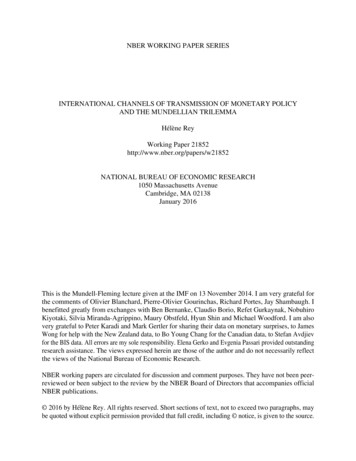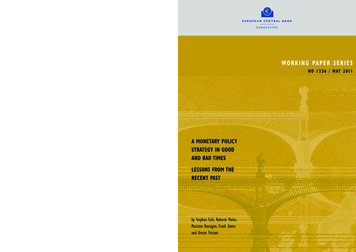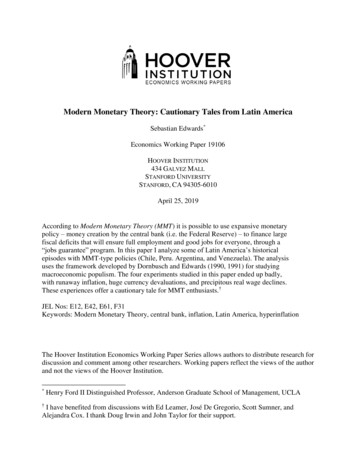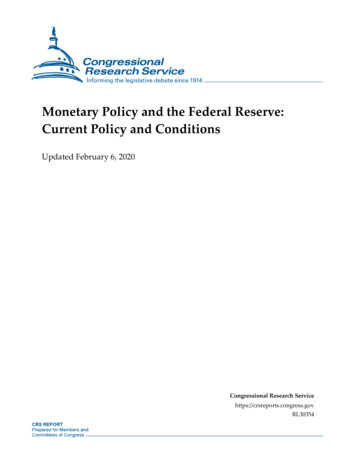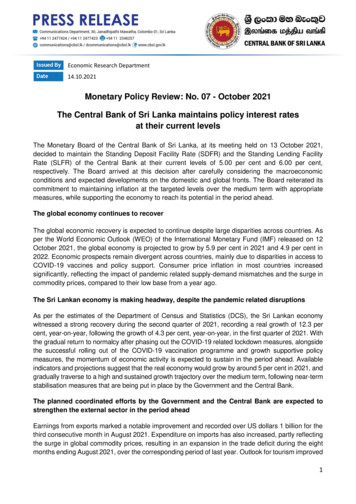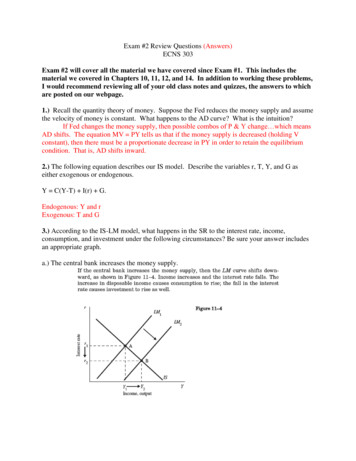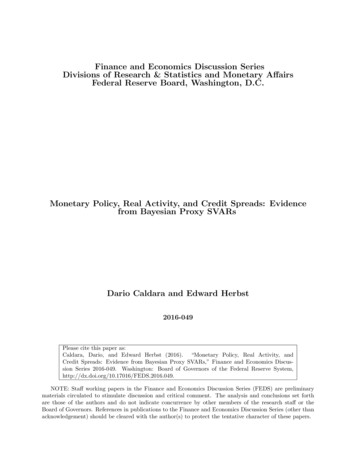
Transcription
Finance and Economics Discussion SeriesDivisions of Research & Statistics and Monetary AffairsFederal Reserve Board, Washington, D.C.Monetary Policy, Real Activity, and Credit Spreads: Evidencefrom Bayesian Proxy SVARsDario Caldara and Edward Herbst2016-049Please cite this paper as:Caldara, Dario, and Edward Herbst (2016). “Monetary Policy, Real Activity, andCredit Spreads: Evidence from Bayesian Proxy SVARs,” Finance and Economics Discussion Series 2016-049. Washington: Board of Governors of the Federal Reserve TE: Staff working papers in the Finance and Economics Discussion Series (FEDS) are preliminarymaterials circulated to stimulate discussion and critical comment. The analysis and conclusions set forthare those of the authors and do not indicate concurrence by other members of the research staff or theBoard of Governors. References in publications to the Finance and Economics Discussion Series (other thanacknowledgement) should be cleared with the author(s) to protect the tentative character of these papers.
Monetary Policy, Real Activity, and Credit Spreads:Evidence from Bayesian Proxy SVARsDario Caldara Edward Herbst†May 24, 2016AbstractThis paper studies the interaction between monetary policy, financial markets, and the real economy. Wedevelop a Bayesian framework to estimate proxy structural vector autoregressions (SVARs) in which monetarypolicy shocks are identified by exploiting the information contained in high frequency data. For the GreatModeration period, we find that monetary policy shocks are key drivers of fluctuations in industrial outputand corporate credit spreads, explaining about 20 percent of the volatility of these variables. Central to thisresult is a systematic component of monetary policy characterized by a direct and economically significantreaction to changes in credit spreads. We show that the failure to account for this endogenous reactioninduces an attenuation bias in the response of all variables to monetary shocks.We thank Domenico Giannone, Yuriy Gorodnichenko, Jim Hamilton, David Lopez-Salido, Andrea Prestipino, Giorgio Primiceri,Juan Rubio-Ramı́rez, Jón Steinsson, Mark Watson, Egon Zakrajšek, Tao Zha, and seminar and conference participants at the FederalReserve Board, the 2015 SED Annual Meetings, the EFSF workshop at the 2015 NBER Summer Institute, Cornell University,Colgate University, and Emory University. All errors and omissions are our own responsibility. The views expressed in this paperare solely the responsibility of the authors and should not be interpreted as reflecting the views of the Board of Governors of theFederal Reserve System or of anyone else associated with the Federal Reserve System. Federal Reserve Board of Governors. Email: dario.caldara@frb.gov†Federal Reserve Board of Governors. Email: edward.p.herbst@frb.gov
1IntroductionStarting with Sims (1980), a long literature has assessed the effects of monetary policy using structural vectorautoregressions (SVARs). Many papers have found that identified monetary tightenings reduce output.1However, the issue is far from settled, with Uhlig (2005) notably finding that monetary policy has no realeffects, and more recent studies finding that the effects of monetary policy on the real economy have becomemuted over time, in particular during the Great Moderation period.2 Furthermore, the consensus in theliterature is that shocks to monetary policy do not significantly contribute to business cycle fluctuations.This paper provides new evidence on the importance of monetary policy for business cycle fluctuations forthe 1994–2007 period. We identify monetary policy shocks by estimating a Bayesian proxy SVAR (BP-SVAR)that exploits information contained in monetary surprises computed using high-frequency data. We find thatpositive monetary policy shocks induce a sustained decline in real economic activity and are accompaniedby a significant tightening in financial conditions. Moreover, at the posterior mean of our preferred VARspecification, monetary shocks explain about 20 percent of the volatility of industrial output and corporatecredit spreads at business cycle frequencies, a contribution about four times larger than standard estimates.Arriving at this conclusion requires explicitly acknowledging the two-way interaction between measuresof corporate credit spreads and monetary policy. On the one hand, several recent papers have concentratedon assessing the transmission of monetary policy through financial markets, both empirically (Gertler andKaradi, 2015; Galı́ and Gambetti, 2015) and theoretically.3 On the other hand, Rigobon and Sack (2003)have provided evidence that monetary policy endogenously reacts to changes in asset prices. Hence, theendogeneity of monetary policy to financial variables and the reaction of asset prices to monetary policypresent a clear identification problem. We document that both channels are quantitatively important. Inour BP-SVAR, monetary policy shocks are transmitted through tightening in financial conditions and, at thesame time, monetary policy displays a large and significant response to changes in corporate credit spreads:All else being equal, a 20 basis point increase in spreads leads to a 10 basis point drop in the federal funds rateat our posterior mean estimate. An implication of the systematic response of monetary policy to financialconditions is that the effects of shocks which originate in or transmit through financial markets—for example,Gilchrist and Zakrajsek (2012)—are substantially smaller in comparison to standard estimates.Our analysis shows that the failure to account for the endogenous response of monetary policy to corporatecredit spreads induces an attenuation bias in the estimated response of real activity to monetary policy shocks.In misspecified models that omit the endogenous response of monetary policy to credit spreads, a monetary1See Bernanke and Blinder (1992); Christiano, Eichenbaum, and Evans (1996); Leeper, Sims, and Zha (1996); Leeper and Zha(2003); Romer and Romer (2004); and, more recently, Arias, Caldara, and Rubio-Ramirez (2015).2See Hanson (2004); Boivin and Giannoni (2006); Boivin, Kiley, and Mishkin (2010); and Castelnuovo and Surico (2010).3Dynamic stochastic general equilibrium models with financial frictions have been pioneered by Bernanke, Gertler, and Gilchrist(1999). Gertler and Karadi (2011) provide a recent application to study the transmission of monetary policy.2
shock is a mix of truly exogenous changes in policy and negative changes in credit spreads (as the elasticityof the fed funds rate to spreads is negative). The bias toward zero happens because a drop in credit spreadsgenerates a persistent increase in real activity.To quantify the effect of this kind of misspecification, we estimate two variants of the model. In particular,we find that monetary shocks identified in a BP-SVAR that omits credit spreads induce no change in industrialproduction. We also show that monetary shocks identified by imposing that the fed funds rate does not reactcontemporaneously to changes in credit spreads (a standard Cholesky identification) induce a decline inindustrial production that is 40 percent smaller than in our preferred BP-SVAR specification. This resultexplains why our findings differ from the conventional wisdom that monetary policy does not contribute muchto business cycle fluctuations.Our paper also provides a methodological contribution to the recent literature on proxy SVARs. Weprovide an encompassing framework that jointly models the interaction between the SVAR and the proxy.In particular, we write the likelihood of a SVAR model augmented with a measurement equation that relatesthe proxy to the unobserved structural shock and estimate the model using Bayesian techniques. A firstadvantage over the standard framework is that inference is valid regardless of the information content of theproxy for the structural shock, requiring no modification for so-called weak instruments, as long as a properprior is specified. A second advantage is that, as we coherently incorporate all sources of uncertainty in theestimation, the proxy becomes informative about both the reduced-form and structural parameters of themodel. A third advantage is that, through prior distributions, we can adjust the informativeness of the proxyfor the estimation of the parameters of the SVAR model.4 That is, researchers that are convinced of thequality of their proxiess can enforce their priors and induce the estimation to take a lot of signal from them.In particular, following Mertens and Ravn (2013), we impose priors on the “reliability” of the proxy, definedas the correlation between the structural shocks identified in the SVAR and the proxies used to identifythem.5Our analysis exploits the Bayesian framework to gain new insights on proxy SVARs by estimating modelsfor different priors on the degree of reliability. In our applications, we find that shrinking the prior toward arelevant proxy—that is, imposing a high reliability of the proxy—can substantially reduce noise and sharpeninference but only if the VAR contains observables that reflect the key transmission mechanisms of monetary policy. By contrast, we show that VAR misspecification in the form of omitted variables introducesendogeneity that can severely bias the dynamic response of the endogenous variables to the shock of interest,regardless of the reliability of the proxy. Moreover, we find that detecting model misspecification is extremely4This feature is one major differentiation of our analysis from other Bayesian approaches: for example, Bahaj (2014) andDrautzberg (2015).5The reliability index is defined as (signal)/(signal noise) and hence is similar to the signal-to-noise ratio in the measurementequation.3
hard, as models with different implications can have an identical degree of reliability.Intuitively, proxy SVARs identify structural shocks by instrumenting the endogenous reduced-form VARresiduals with exogenous proxies for the unobserved structural shocks. A high degree of reliability mostlysignals that the proxy can be a good instrument in these IV-type regressions, and that we can obtain reliableestimates of the contemporaneous response of the endogenous variables to the structural shock. However, thereliability indicator is silent about the possibility of missing key variables in the system that could alter thedynamic responses of all variables to the shock. This is why, even with a well-constructed and reliable proxy,if the VAR is misspecified, the BP-SVAR will provide misleading inference. Hence the argument of Romerand Romer (2010), that observing a carefully constructed proxy closely related to the policy shock yields anunbiased estimate even in the presence of omitted variables, does not apply to this methodology.Our methodological results have important implications for the existing literature on proxy SVARs. Theresult that the specification of the VAR model is consequential for inference, irrespective of the quality of theproxy, is important because most of the literature focuses on the relevance and exogeneity of the proxy ratherthan the specification of the VAR model. Consequently, the importance of model misspecification and theimpossibility of correcting it through the priors motivates the estimation of large systems, and the Bayesianframework is particularly well-suited to this task.The starting point of our analysis is Gertler and Karadi (2015), who also employ a monetary proxySVAR that includes financial variables. Indeed, we document similar responses of real activity and corporatecredit spreads to monetary policy shocks. However, relative to Gertler and Karadi (2015), we show that theaddition of corporate credit spreads to the proxy SVAR leads to a dramatic difference in the response of allmodel variables to the monetary shock and, in terms of forecast error variance, makes such monetary shocksimportant drivers of the cycle. In addition, we characterize the endogenous component of monetary policyand show that although it reacts contemporaneously to corporate credit spreads and stock returns, it doesnot react contemporaneously to prices, several measures of real activity, or mortgage spreads. Finally, weprovide a Bayesian framework for inference and derive implications for the literature on proxy SVARs thatextend beyond our application to monetary policy.In our empirical analysis, we use the proxies for monetary policy shocks constructed from high-frequencydata around Federal Open Market Committee (FOMC) statements. Price changes in federal funds ratefutures during a narrow window around FOMC statements provide a measure of the unexpected componentof monetary policy, which we aggregate to a monthly frequency. Our paper follows the literature, pioneeredby Kuttner (2001), that uses event studies to examine monetary policy shocks. Other influential studiesinclude Bernanke and Kuttner (2005); Gürkaynak, Sack, and Swanson (2005); Campbell, Evans, Fisher, andJustiniano (2012); and Gilchrist, López-Salido, and Zakrajšek (2015). The bulk of these studies consider4
simple univariate regressions for assessing the effects on monetary policy on daily changes in asset prices. Incontrast, we are more concerned with studying the interaction between monetary policy, and macroeconomicand financial conditions. Therefore, we use a VAR as our principal framework for analysis.6The paper is structured as follows. Section 2 describes the BP-SVAR model and the estimation procedure.Section 3 describes the data. Section 4 shows the main empirical findings based on small proxy SVARs.Section 5 documents how identification and inference depend on the informativeness of the proxy. Section 6extends the analysis to larger models. Section 7 explores robustness to alternative measures of corporatecredit spreads. Section 8 concludes.2Econometric MethodologyIn this section, we first describe a standard SVAR model and illustrate the identification problem froma Bayesian perspective. We then present the BP-SVAR, the prior distributions, and the sampler used todraw from the posterior distribution. Finally, we discuss some key properties of the model and the model’srelationship with the literature.2.1The SVAR ModelConsider the following VAR, written in structural form:yt0 A0 pX0yt A c e0t ,for 1 t T,(1) 1where yt is an n 1 vector of endogenous variables, et is an n 1 vector of structural shocks, A is an n nmatrix of structural parameters for 0 p with A0 invertible, c is a 1 n vector of parameters, p is thelag length, and T is the sample size. The vector et , conditional on past information and the initial conditionsy0 , ., y1 p , is Gaussian with a mean of zero and covariance matrix In (the n n identity matrix). The modeldescribed in Equation (1) can be written asyt0 A0 x0t A e0t ,for 1 t T,(2)00, . . . , yt p, 1]0 and A [A01 , . . . , A0p , c]0 . The reduced-form representation of this model iswhere xt [yt 1given byyt0 x0t Φ u0t ,ut N (0, Σ).6(3)In an early work, Faust, Swanson, and Wright (2004) use the responses of federal funds rate futures contracts to FOMCannouncements to identify a VAR but omit measures of financial conditions.5
The reduced-form parameters and the structural parameters are linked throughΣ (A0 A00 ) 1 and Φ A A 10 .(4)When the object of interest is, say, assessing the effects of shocks et on observables or decomposing thestructural sources of fluctuations, the econometrician requires knowledge of (potentially a subset of) theparameters (A0 , A ). As is well known, without additional restrictions, it is not possible to obtain uniqueestimates of the structural parameters given the reduced-form parameters. This is because it is impossible todiscriminate between the many possible combinations of structural shocks that yield the same reduced-formresiduals, ut ; that is, the likelihood is flat with respect to these combinations. To see this, let Σtr be thelower-triangular Cholesky factorization of Σ and let Ω O(n), where O(n) is the space of all orthogonalmatrices of size n n, so that0A0 Σ 1tr Ω.(5)It can be verified that any two orthogonal matrices Ω and Ω̃ O(n) yield two sets of structural coefficientsA0 and Ã0 that give rise to identical likelihoods. The majority of the literature, beginning with Sims (1980),has used theoretical restrictions to achieve identification—that is, to inform choices of Ω. The Bayesianframework incorporates the information from theoretical restrictions in the form of a distribution over Ω,denoted by p(Ω). To see how the data and the restrictions imposed on Ω interact, we can decompose thejoint distribution of data and parameters as follows:7p(Y1:T , Φ, Σ, Ω) p(Y1:T Φ, Σ)p(Φ, Σ)p(Ω).(6)The first density on the right-hand side of Equation (6) is the likelihood function for Y1:T , which does notdepend on Ω. A direct implication is that the distribution for Ω is not updated in light of the data:p(Ω Y1:T ) p(Ω).(7)Because the data do not contain information on p(Ω), most debates in the SVAR literature are about the“correct” choice of distribution for any given application. For instance, in many cases, p(Ω) is dogmatic inthe sense that it implies probability one to a single Ω. A common dogmatic identification scheme is to setWe use the notation Y1:T for [y1 . . . yT ]0 . In this and what follows, we suppress any dependence on the initial conditions Y p:0for convenience.76
Ω In , which corresponds to the widely used Cholesky factorization of Σ.82.2The Bayesian Proxy SVARIn this paper, we follow a different strategy and inform the choice of Ω by incorporating additional data, theproxies, that contain information about a subset of the structural shocks in the SVAR. Proxies are typicallyconstructed using event studies, microdata, or high-frequency data, and hence contain information aboutthe structure of the model coming from sources of variation that are external to the SVAR. Key to ourmethodology is to use a probability distribution that does not rule out any Ω a priori and incorporate theproxy in the SVAR so that prior beliefs p(Ω) are updated by the proxy in a probabilistic way.9In what follows, we take the proxy, mt , to be an observation from a scalar-valued time series of length T .We link mt to a particular structural shock of interest that, without loss of generality, we assume is the firstshock e1,t . The relationship between mt and e1,t is given bymt βe1,t σν νt ,νt N (0, 1) and νt et .(8)The formulation in Equation (8) has two implications. The first is that the squared correlation between mtand e1,t ,2ρ CORR (mt , e1,t ) β2,β 2 σν2(9)measures the “relevance” of the external information for the structural shock of interest. Mertens and Ravn(2013) call ρ the reliability indicator for the proxy. Equation (8) makes clear that the reliability indicator isdirectly related to the signal-to-noise ratio β/σ. The larger this value, the more information the proxy bringsto bear on the identification of the SVAR. The second implication of Equation (8) is that mt is orthogonalto other structural shocks in the VAR, e/1,t : E mt e/1,t 0.(10)Equation (10) conveys the exogeneity of the proxy. This condition ensures that our proxy is only informativeabout a single shock or, equivalently, a single column of Ω. These two conditions are very similar to those8More generally, researchers allow for this distribution to depend on the reduced-form parameters, writing this prior as p(Ω Φ, Σ).Many common prior distributions—ones based on sign restrictions, for example—exhibit this dependence. As in our framework,p(Ω) does not depend on (Φ, Σ), we suppress this dependence for notational convenience. Del Negro and Schorfheide (2011) surveyhow many common identification schemes map into assumption on Ω.9The framework is a Bayesian implementation of the proxy SVAR approach of Stock and Watson (2012) and Mertens andRavn (2013). The proxy structural VAR approach has been motivated as an instrumental variable approach for the reduced-formresiduals, but Mertens and Ravn (2013) show that, under some restrictions, it is equivalent to a model in which the proxy is simplya linear function of the structural shock of interest subject to measurement error.7
required of an instrument in an instrumental variables regression. The setting, however, is different: Inpractice, what matters is the relationship between mt and ut , the unobserved structural shock from theSVAR.To examine in detail how the proxy interacts with the rest of the structural VAR, we augment Equation (1)00with Equation (8). Letting ỹt [yt0 , mt ] , ẽt [e0t , νt ] , and similarly defining x̃t , we can rewrite Equation (1)as a system of equations for ỹt :ỹt0 Ã0 x̃0t à ẽ0t .(11)The structural matrices Ã0 and à are functions of the original structural VAR matrices, (A0 , A ), and theparameters governing the proxy equation, (β, σν ), with A0 βσ A·1,0O1 n1σÃ0 A βσ A·1, O1 n0 , and à .(12)As can be seen from Equation (12), the proxy SVAR is an augmented SVAR that links the proxy to thestructural shock of interest through the structural coefficients associated with it.2.3Understanding Identification in BP-SVARsTo understand how identification works in BP-SVARs, it is instructive to write the joint likelihood functionfor Y1:T and M1:T :p(Y1:T , M1:T Φ, Σ, Ω, β, σν ) p(Y1:T Φ, Σ)p(M1:T Y1:T , Φ, Σ, Ω, β, σν ).(13)The first term on the right-hand side of Equation (13) is the likelihood of the VAR data Y1:T . Thislikelihood contains information only about the reduced-form parameters Φ and Σ. The second term, whichis unique to BP-SVARs, is the conditional likelihood of the proxy M1:T given the VAR data Y1:T , which hasthe following closed-form solution:10M1:T Y1:T , Φ, Σ, β, σν µM Y βΩ0·1 Σ 1tr (Y1:Twith0 0 X1:T Φ) and N µM Y , VM Y ,VM Y σν2 IT ,(14)where µM Y and VM Y are the mean and variance, respectively, associated with the normally distributedlikelihood. Because the conditional likelihood of the proxy M1:T given Y1:T is a function of all parameters of10See the Appendix for the derivations.8
the proxy SVAR all prior distributions, including p(Ω), are updated in light of the information contained inthe proxy. As we see from the expression for µM Y , for given values of Φ, Σ, β, and σν , the econometricianupdates the beliefs about the identification of the structural shock e1 by giving relatively more weight to Ωs,which results in linear combinations of “standardized residuals” (Σ 1tr ut ) that look like a scaled version of theproxy. Similarly, for given values of Ω, β, and σν , the econometrician updates the beliefs about the reducedform coefficients Ψ and Σ by giving relatively more weight to the reduced-form residuals that span the proxymt . This coherent modeling of all sources of uncertainty through the joint likelihood, and, hence, the abilityto exploit the information content of the proxy to estimate both reduced-form and structural parameters ofthe BP-SVAR, consitutes a first advantage of our framework over traditional proxy SVAR models.The expressions for µM Y and VM Y reported in Equation (14), as well as the expressions for the structuralmatrices described by Equation (12), also reveal that the signal-to-noise ratio β/σ is crucial for identifying thecoefficients of the SVAR. When β/σ is large, mt provides a lot of information about e1,t and, consequently,0about the structural parameters A·1,0 (or, equivalently, about Ω0·1 Σ 1tr (Y1:T X1:T Φ) ). However, whenβ 0, mt is simply noise and provides no information about A·1,0 . Finally, when β/σ is close to zero, butnot zero, we have weak identification.A second advantage of the BP-SVAR over standard proxy SVARs estimated using a frequentist approach isthat in a Bayesian setting, weak identification does not pose a problem per se—as long as the prior distributionis proper, inference is possible.11 Although a comprehensive analysis of this issue is outside the scope of thispaper, it is important to highlight that in the case of weak identification, the prior plays an important rolein inference. But in our framework, comparing prior to posterior distributions, a standard diagnostic checkto detect weak identification is trivial. The reason is that, as already shown by Equation (13), when it comesto identification, the relevant prior distributions are those implied by the model before observing M1:T butafter observing Y1:T , as the VAR data are not informative about Ω. Drawing from this prior is easy and isachieved by combining draws from Φ, Σ Y1:T with draws from the prior from Ω.A third advantage over the standard framework is that, through prior distributions, we can adjust theinformativeness of the proxy for the estimation of the parameters of the BP-SVAR model. In practice,researchers construct proxies to be relevant—that is, to contain a lot of information about the structuralshock of interest. This effort is consistent with a prior view of a high degree of reliability ρ, or, equivalently,of a high signal-to-noise ratio β/σ. We operationalize this kind of prior, along with more diffuse ones, byconstructing prior distributions where ν can only explain a fraction of the variation in M1:T .12This kind of prior shrinkage is not a panacea, though. In sections 4 and 5, we show that shrinking the prior11See, for instance, Poirier (1998). Of course, lack of identification or weak identification, which manifests itself as flat or nearlyflat likelihood profiles, could pose practical issues when sampling the posterior.12There are many ways of doing this. One could use a change of variables and parameterize ρ directly, for instance.9
toward a relevant proxy—that is, imposing a high reliability of the proxy—can substantially reduce noiseand sharpen inference but only if the VAR contains observables that reflect the key transmission mechanismsfor the shock of interest. By contrast, we show that VAR misspecification in the form of omitted variablesintroduces endogeneity that can severely bias inference, regardless of the reliability of the proxy. Moreover,we find that detecting model misspecification is extremely hard, as models with different implications canhave an identical degree of reliability.The analytical expression for µM Y can help shed light on these features of proxy SVARs. The reliabilityof the proxy is determined by its contemporaneous relationship with the reduced-form residuals of the endogenous variables included in the model. Hence, a proxy can be highly reliable because it contains informationabout the impact responses of some variables. But in most applications—including the application to monetary policy presented in this paper—researchers are interested in the dynamic responses, as the effects ofmany macroeconomic shocks occur only after a substantial delay. The dynamic propagation of the (correctlyestimated) impact responses uniquely depends on the specification of the VAR model and is mostly unrelatedto the reliablity of the proxy. In fact, although in principle misspecified dynamics could be reflected in theestimation of ut and hence be reflected in the reliability of the proxy, in practice we find that the impact onmisspecification on the reliability indicator is extremely modest. Although it is true that variable omissioncan affect inference in a large class of models (Sims, 1992), and not just in proxy VARs, we think it is worthunderscoring this feature of proxy SVARs, as the literature has placed a large emphasis on the proxy and noton the specification of the VAR model.2.4Prior Distributions and Posterior SamplerPrior Distributions. We assume independent prior distributions for (Φ, Σ), Ω, and (β, σν ), so we canfactorize the joint distribution asp(Φ, Σ, Ω, β, σν ) p(Φ, Σ)p(Ω)p(β, σν ).The advantage of working with independent priors is that we have more flexibility to select prior distributionsfor the different blocks of the parameter space, which we discuss next.The prior on the reduced-form parameters p(Φ, Σ) is parameterized so that the prior is conjugate to thelikelihood p(Y1:T Φ, Σ). The implication is that the posterior conditional on the VAR data Y1:T is knownin closed-form. For densely parameterized models, statistical shrinkage is necessary, so we use a MinnesotaPrior, which has a multivariate normal-inverse Wishart form. Specifically, we use the dummy observationimplementation of the Minnesota Prior discussed in Del Negro and Schorfheide (2011).Key to our approach is to choose a prior for Ω that is easy to sample from and that ensures a good10
coverage of O(n), the set of all orthonormal matrices. To this end, we use the uniform prior discussed inRubio-Ramı́rez, Waggoner, and Zha (2010). This prior can be sampled from by drawing an n n matrixwhere each element is an independent random normal draw. The QR factorization of this matrix, with Rhaving positive diagonal elements, gives Ω.13The prior for β and σν can be chosen to be conjugate to the likelihood function. In what follows, wemaintain a general prior p(β, σν ) and do not exploit conjugacy to give us the flexibiltiy to shrink the priorp(β, σν ) to impose a higher signal-to-noise ratio. We choose the following distributions:p(β) p(σν ) N (µβ , σβ ),(15)U[0, σ̄ν std(M1:T )].(16)The standard deviation of the measurement error σν is uniformly distributed between zero and an upper boundthat is a function of the standard deviation of the proxy.14 The parameter σ̄ν , as previously mentioned, allowsus to scale a priori the amount of variance of the proxy that can be explained by measurement error. A lowupper bound on σν forces the estimation to generate a small measurement error and hence to take a lot of signalfrom the proxy. Using the priors for β and σν , we can ded
Federal Reserve Board, Washington, D.C. Monetary Policy, Real Activity, and Credit Spreads: Evidence from Bayesian Proxy SVARs Dario Caldara and Edward Herbst 2016-049 Please cite this paper as: . Arriving at this conclusion requires explicitly acknowledging the two-way interaction between measures of corporate credit spreads and monetary .
